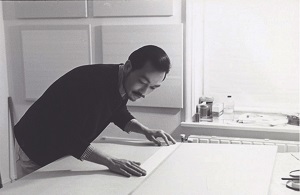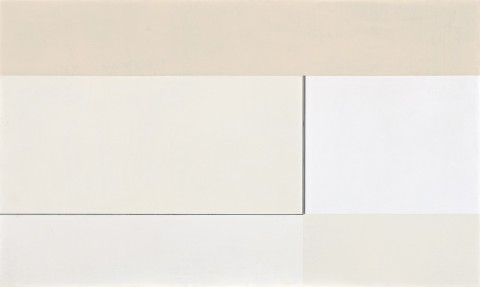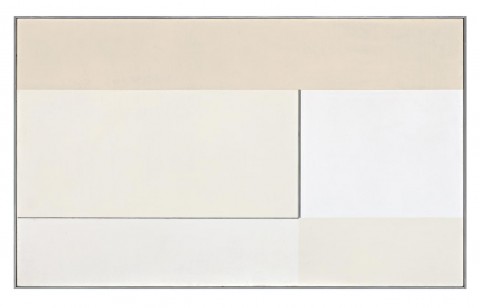PAINTING WITH ALUMINIUM BAR, 1962
RICHARD LIN (LIN SHOW-YU)
oil and aluminium on canvas
76.0 x 127.0 cm
signed and dated on stretcher bar verso: Lin Show Yu May 1962
bears inscription on stretcher bar verso: 50 LINS 18
Gimpel Fils, London (label attached verso)
Colonel Aubrey Gibson, Melbourne, acquired from the above in 1962
Thence by descent
Private collection, Melbourne
Melbourne Fine Art Gallery, Melbourne
Private collection, Melbourne, acquired from the above, December 1998
Melbourne Fine Art Gallery, Melbourne, November – December 1998, cat. 82
Miller, R., ‘the art collectors 2: Colonel Aubrey Gibson’, Art and Australia, Ure Smith, Sydney, vol.2, no.3, December 1964, p. 173 (illus.)
‘White is the most ordinary of colours, it is also the most extraordinary; it is the absence of colour, it is also the sum of colours; it is the most majestic of colours, it is also the most common; it is the colour of tranquility, it is also the colour of grief’.1
Richard Lin.jpg

Richard Lin (Lin Show-Yu) in
his studio, 1968
After living and working in England for five decades virtually without acclaim, today late Taiwanese artist Richard Lin is finally receiving the recognition he deserves as one of the leading artists of the twentieth century. Only last month, the first European retrospective exhibition of his oeuvre, ‘Richard Lin: Selected Works from the Artist’s Estate’, was hosted by global auction house Bonhams at their London headquarters; and over the past year, seven of the top ten highest prices for Lin’s work have been realised at auction worldwide. No doubt fundamental to the compelling appeal of Lin’s sublime achievements is his highly unique artistic vision – born from an amalgamation of both Eastern and Western cultures, of Oriental and Occidental aesthetics. For while the elegant simplicity of his geometric abstractions such as the present Painting with Aluminium Bar, 1962 evokes unmistakable parallels with Minimalism, Lin notably also stands apart from this formal movement and its emphasis on rationality and the elimination of all emotion or expression. Rather, his masterpieces emanate a subtle energy and fluid sensuality hidden beneath the surface of the picture plane that is directly inspired by Eastern philosophies, and specifically, the abstract landscapes of Mi Fu, a Song Dynasty master working nine centuries earlier. Straddling such dualistic perspectives – one Western and representational, the other Eastern and spiritual – thus Lin occupied what anthropologist Levi Strauss defines as that ‘in-between’ space between multiple worlds, afforded the rare opportunity ‘to glimpse through many slightly ajar doors’ yet paradoxically belonging everywhere, and nowhere, at once; as the artist’s daughter Katya poignantly muses, ‘… my father often felt like a stranger, almost everywhere’.2
Born into a prominent Taiwanese family in 1933, Lin lived a cossetted life before being sent to study in Hong Kong in 1949, and subsequently, at Millfield, an exclusive independent co-educational school in Somerset, England. In 1954, within two years of arriving in England, he was accepted at the fashionable Regent Street Polytechnic to study Western art and architecture where he absorbed the influences of major artistic movements including de Stijl, Bauhaus, Cubism and Abstract Expressionism, and key figures such as Le Corbusier, Ben Nicholson, Mark Rothko and Piet Mondrian. Upon his graduation in 1958, Lin was promptly offered his first show at the Institute of Contemporary Arts, London and in 1964, he was invited to participate in Documenta III at Kassel, Germany where – as the first Chinese artist to be included in this prestigious exhibition – he represented Britain with works from his signature ‘Painting Relief’ series. A complex narrative, Lin’s stylistic evolution began with semi-abstract landscape paintings in the late 1950s, followed subsequently by more traditional works inspired by Chinese calligraphy and ink-and-wash painting, before he finally embraced his celebrated ‘White series’ – the artist’s hallmark genre which he would continue to explore until 1984 when, abruptly declaring the death of painting, he turned his attention instead to three-dimensional arts.
As encapsulated by the magnificent Painting with Aluminium Bar offered here, Lin’s iconic White paintings feature the careful arrangement of whites of various different depths and shades to create compositions that are meticulous and precise, yet simultaneously fluid and energetic. While there are undeniable elements of minimalism – the departure from representational form; the use of only rectangles and lines; and the almost undetectable brushstrokes – Lin is not regulated by the purely logical placement of shapes, nor does he insist upon eradicating all emotion or denouncing lyricism. To the contrary, if one observes the painting long enough, one begins to realise that it is not so detached or inaccessible; there is a greater energy, a presence within the absence. Thus highlighting the difference between seeing with one’s eyes and perceiving with one’s spirituality, Painting with Aluminium Bar represents an exquisite example of Lin’s enduring legacy – his powerful ability to transcend space and time. As the artist himself reflected enigmatically upon his half-century long career in the catalogue accompanying his exhibition at the Kaohsiung Museum of Fine Arts, ‘What is before us? There are not enough words to describe and no words to do so aptly. Anything can be something; there is no difference between anything and anything is everything’.3
1. Richard Lin
2. The artist’s daughter Katya cited in Harris, G., ‘Whiter Shade of Pale’, Bonhams Magazine, August 2018, Issue 56, pp. 44 – 47
3. Lin cited in ‘Introduction’ in Richard Lin, ex.cat., Kaohsiung Museum of Fine Arts, Taiwan, 2010
VERONICA ANGELATOS

